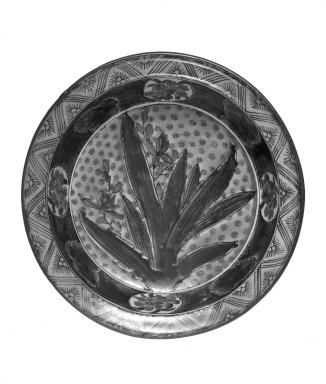
Artist:Yoshidaya kiln
Medium: Kutani ware porcelain with overglaze enamel decoration
Geograhical Locations:
Dates:early 19th century
Dimensions: 2 3/4 x 9 3/4 in. (7 x 24.8 cm)
Collections:
Exhibitions:
Accession Number: 75.201
Image: 75.201_bw.jpg,
Catalogue Description: Yoshidaya kiln Kutani Ware Porcelain Bowl. Buff-colored porcelain covered except for footrim with a clear glaze and overglaze green, yellow, aubergine, blue, and black enamels. Bowl with prominent footring, flat bottom, straight sides, and strongly everted rim. Interior of foot yellow with green and black "fuku" mark. Outside green with black cloud spirals. Inside, the bottom is filled with an iris plant in green and aubergine on a yellow background, while the sides have round panels of paired aubergine and blue cherry blossoms alternating with aubergine peonies against a green leaf background. The rim has a black linear zigzag pattern and repeated "three jewels" motif on a yellow background. Condition: excellent; minor surface scratches on interior. Yoshidaya: Professional name of Toyota Denuemon IV, AKA Sekio, born 1751. Invested in kiln to make Ko-Kutani wares, but not in Kutani, in Yamashiro. Died 1827. Kiln shut down after the death of most family memebers and economic difficulty. Kiln founded in 1826; closed in 1834. The Yoshidaya kiln was a short-lived venture, situated in Yamashiro, intended to revive Kutani-style wares. The founding investor was Toyota Denuemon IV (aka Sekio, lived 1751-1827), a businessman who used the professional name Yoshidaya. He chose not to situate his kiln in Kutani because of the site's remote location, but his wares emulate the earlier Kutani wares in a variety of ways.